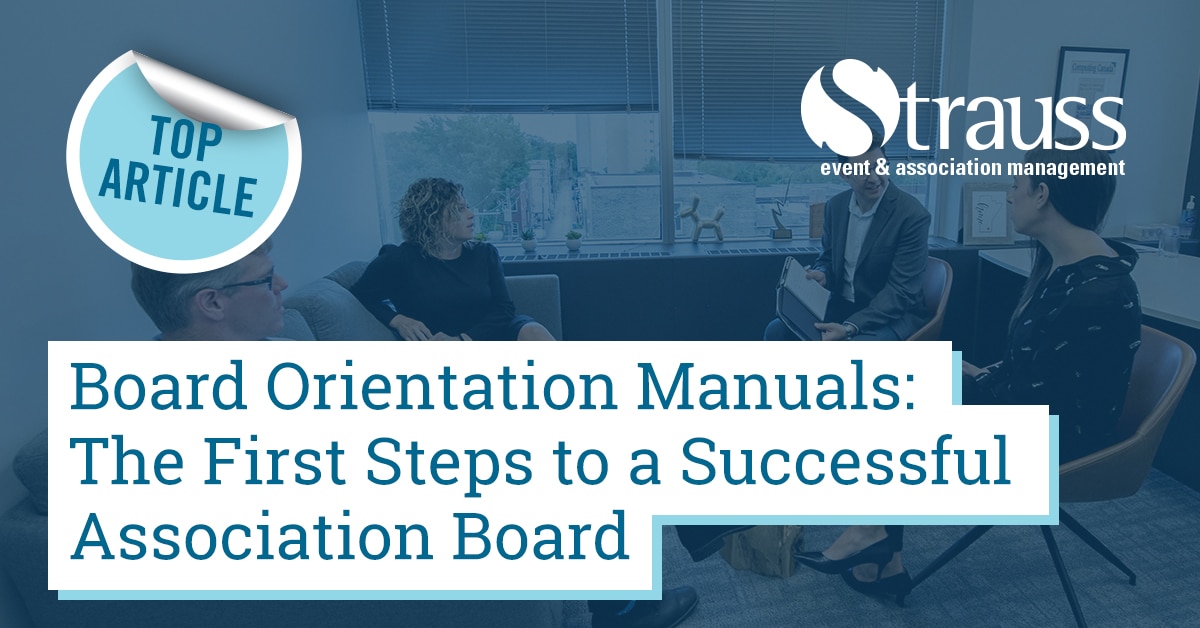Board orientation manuals are crucial to all association board members. A board orientation manual is the ultimate resource for existing board members and should always be presented to new board members as an important component of training them for their new volunteer position. Manuals should include everything a board member would need to know about the history, actions, and goals of the association, down to the most detailed information that a director may need, so that even the newest board member can learn about the organization and the governance structure.
It is the role of the board of directors and association staff to ensure that your association’s board orientation manual is cohesive, useful and kept up to date. This article will cover the importance of understanding and using your association’s board orientation manual while also explaining my experience creating these documents for associations with which I work .
If applicable, your association’s board orientation manual should contain, but should not be limited to, the following sections:
- History of the organization and board
- Current board and senior staff contact information
- Association organizational chart (committees, staff, etc.)
- Policies and procedures
- Calendar of events
- Strategic plan
- By-laws
- Additional resources/appendices
Some of these sections will be covered further in the paragraphs below. To learn more about the contents of your orientation manual, read past our article, The Association Board Binder.
Navigating the Manual
First off, all the information in the manual should be organized in a cohesive manner. By making it easy to understand, board members will be more inclined to utilize this resource and consult it in times of need. Ensure that the table of contents (ToC) is clear and easy to navigate. Act as if you were a board member with a specific question, does your table of contents tell them where to find this answer? If you believe the ToC is comprehensive, the answer to that question should be yes.
Be sure to take advantage of hyperlinks throughout the document. This tool will become beneficial as the document as a whole is quite extensive. Hyperlinks will allow board members to navigate the document without having to scroll repeatedly. It can also allow for webpages and any hosted media to be linked into the manual.
Manual Contents
As briefly mentioned above, some sections to include in your board orientation manual have been recommended. Now to further delve into some of these sections:
Policies & Procedures
Pertinent board policies and procedures must be included in the orientation manual. This information is indispensable to any board member seeing as their decisions will be affected by these policies. This will allow them to do that work with ease and confidence. In the policies and procedures section, you should also include any relevant contracts. For example, you could have the conflict-of-interest policy followed by the conflict-of-interest contract that all association volunteers must sign. You can also use a hyperlink and include the contract elsewhere in the document, if necessary.
Calendar of Events
The orientation manual should also contain a calendar of major events that typically happen throughout the year. Board members use this can use this to stay organized and reassured, keeping their calendars up to date and their tasks in order. Be sure to include conferences, AGM, board meetings (in-person and videoconferences), and any other relevant/regular events they may need to attend to help board members plan their year.
Additional Resources
Additional information in appendices and addendums ensures no information is lost or left out, so be sure that board members know to review this section. This section would include their full strategic plan, investment policy statements, external resources, and agreements that are important for all board members to be aware of.
New Board Members
Reading over this information may be a board member’s first impression of their new volunteer role, so it should be well organized and written with care. New board members should take the time to really understand the details within the board manual and should be encouraged to ask questions.
The importance of a proper orientation for new board members is very significant. They are volunteering to represent the best interest of the association membership and act in an educated, and thoughtful manner. Providing them with the tools they need to complete this will permit the association to grow in a worthwhile way.
For more on the importance of proper board orientation, read Board Member Orientation — A Great Way to Strengthen Your Association.

